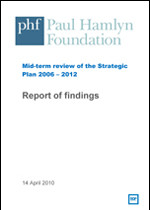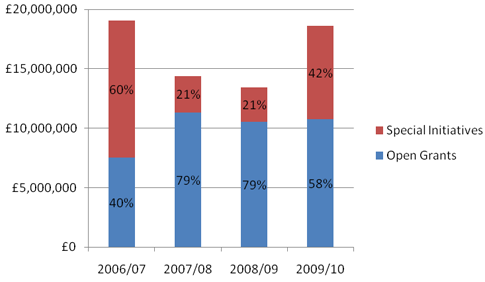3 Main activities and achievements
We have set ourselves ambitious aims, and we will be working in sometimes difficult and often uncharted territory. The scale of the plan requires the Foundation to be transformed over the next few years. We have already experienced considerable change since 2001 and believe we have the skills and capacity to transform ourselves further to meet the objectives out in this plan.
Introduction to Strategic Plan 2006-2012
Paul Hamlyn Foundation is making the transition from a traditional grant-maker to a strategic philanthropist. This involves giving out considerably more money in a more strategic way and transforming the way it operates and thinks of itself.
As planned, annual giving has increased to £20m per year, spread fairly evenly across the three UK programme areas, with a smaller amount going on the India Programme. Total grant expenditure to the end of 2009/10 will be just under £70 million.
The Special Initiative is the hallmark of the Strategic Plan – and one of the hallmarks of a strategic philanthropist. The Foundation has launched six since 2006 – with two in the pipeline. These now account for 40% of annual expenditure, in line with the 50% target.
The Foundation has made 400 awards in response to over 4,000 applications under the Open Grants scheme.
Table 1: Annual Grant Expenditure: 2006-2009
The Foundation has successfully transformed its own management and operational structures in order to pursue the aims of the Strategic Plan. In 2006 the executive was restructured around the four main programme areas, with the recruitment of Programme Directors, newly formed programme committees and special advisors (all but one of them new) for each programme. The number of staff has doubled, bringing in a much broader mix of skills to deal with the increased volume of grant giving and the Special Initiatives.
At the level of governance there are four new trustees (out of nine), recruited for their knowledge of Foundation’s programme areas but also their expertise in other broader areas such as finance and public affairs. Decision-making for individual grants is primarily delegated to the programme committees.
In 2007 the Foundation implemented a new ‘outcome-based’ approach to grant-giving for its Open Grants. This has resulted in a more rigorous grant-making and reporting process – and, as discussed later, with further refinements should give the Foundation a better sense of the impact of its investments in the longer term.
The Foundation has considerably increased the scale and diversified the range of its giving in India, establishing a permanent office there for the first time in 2010.
In May 2007 the Foundation donated £10m to establish the Paul Hamlyn Education Fund within the Royal Opera House Endowment Fund. In recognition of this gift the Floral Hall was renamed the Paul Hamlyn Hall, thus fulfilling the trustees’ aim of making one single large grant to create a permanent commemoration of Paul Hamlyn. This is categorised as a Special Initiative in the analysis of grant expenditure for 2006/07 in Table 1.
There are ongoing improvements to communications. This includes a new website (with an online application process), email newsletters, and a distinctive Yearbook which summarises the achievements of the Foundation, and which is viewed as exemplary by other foundations.
The Foundation has a good reputation in the fields in which it works. According to the recent Grantee Perception Report, grantees increasingly see the Foundation as an effective organisation and mostly have a positive experience in their interactions with it. The Foundation is viewed as a ‘precise and imaginative’ by non-grantees. But there is a clear desire amongst this group for clearer communication about learning and impact and even more partnership working.
We’re in the third phase of our existence. When we started we were about audience development. Musical Futures defined the second phase: it taught us to be more strategic. This third phase seems to be defined by our Special Initiatives, especially Right Here, which seems right for the times, both in approach and subject matter.
Trustee
The table in Appendix 1 illustrates the breadth and diversity of the Foundation’s activity by setting out the main milestones reached over the last four years.
Appendices 2 and 3 contain a more detailed analysis of the Foundation’s finance and grants data including levels and types of expenditure, grant-giving by programme area, type of activity and age group, and resources devoted to capacity building and evaluation.

